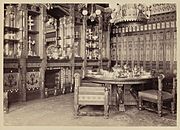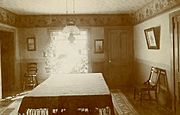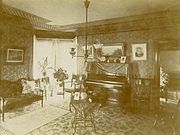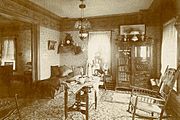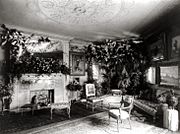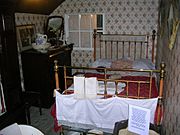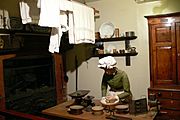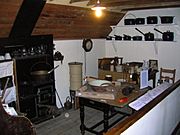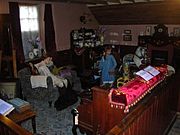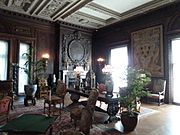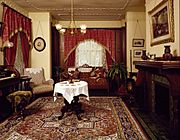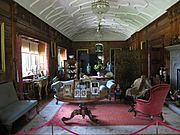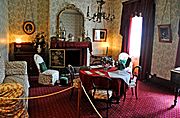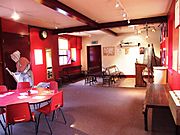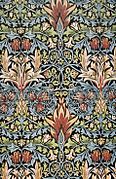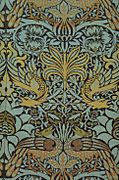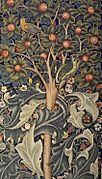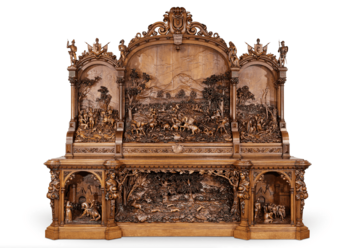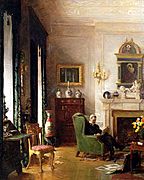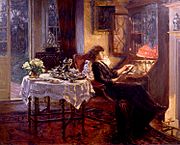Victorian decorative arts facts for kids
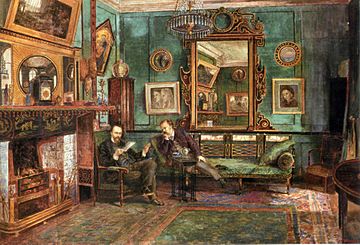
Victorian decorative arts are all about the cool styles of art and design from the Victorian era. This was a time when Queen Victoria ruled England, from 1837 to 1901. People often think Victorian design had a lot of fancy decorations. It was known for mixing old styles with new ideas. Designers also brought in influences from Asia and the Middle East. This could be seen in furniture, house fittings, and how rooms were decorated. Important art movements like the Arts and Crafts movement and Art Nouveau started during this period.
Contents
Inside Victorian Homes
Victorian homes were very neat and full of decorations. People carefully separated public rooms from private ones. A room with no decorations was seen as boring. So, every space was filled with items. These items showed what the owner liked and what they hoped for.
The living room, called the parlour, was the most important room. It was where homeowners showed off their style. Guests were always entertained here. The dining room was the second most important room. The sideboard (a piece of furniture for serving food) was often the main focus. It was usually very fancy and decorated.
Old Victorian Rooms
-
Victorianparlor.jpg
A parlor in a New York House from the 1850s.
-
The parlor of the Whittemore House in Washington, D.C.
Preserved Private Rooms
-
A bedroom from the 1890s at the James A. Garfield National Historic Site.
-
A Victorian bedroom on display at Dalgarven Mill – Museum of Ayrshire Country Life and Costume.
Preserved Public Rooms
-
The living room at Vanderbilt Mansion National Historic Site.
-
The parlor of the Emlen Physick Estate in New Jersey, 1879.
Walls and Ceilings
The paint color on walls in Victorian homes depended on the room's use. Hallways and stair halls were often painted a dark gray. This was so they wouldn't take attention from other rooms. Many people made their walls or wood look like marble. They would score wet plaster to make it look like stone blocks.
Doors and woodwork often had finishes that looked like marble or wood grain. "Graining" meant making cheaper wood look like more expensive types. There were special rules for choosing colors. "Harmony by analogy" meant using colors next to each other on the color wheel. "Harmony by contrast" meant using colors opposite each other.
A popular wall design had three parts. There was a dado or wainscoting at the bottom. The middle part was called the field. At the top was a frieze or cornice. This style was popular even into the 20th century.
Frederick Walton invented Lincrusta in 1863. This was a material like wallpaper made from linseed oil. It could be embossed (given a raised pattern) to look like wood or leather. Ceilings were usually high, about 8–14 feet. Their color was often three shades lighter than the walls. Decorated ceilings were very popular.
Wallpaper Designs
Wallpaper became much easier for more people to buy. This was because of new ways to make it in large amounts. Also, in England, a tax on wallpaper was removed in 1836.
Early Victorian wallpaper often had detailed flower patterns. They used primary colors (red, blue, yellow) in the background. Cream and tan colors were printed over these. Later, wallpaper inspired by Gothic art became popular. These had earthy colors with stylish leaf and flower patterns.
William Morris was a very important designer of wallpaper and fabrics. He worked in the later Victorian period. Morris was inspired by Medieval and Gothic tapestries in his designs. Embossed paper was also used on ceilings and friezes.
-
Artichoke wallpaper, designed by John Henry Dearle for Morris & Co., around 1897.
Victorian Furniture
There wasn't just one main style of furniture during the Victorian period. Designers often used and changed many styles from history. These included Gothic, Tudor, Elizabethan, English Rococo, and Neoclassical styles. The Gothic and Rococo revival styles were the most common in furniture at this time.
See also
- Victorian fashion
- Victoriana
- Eastlake movement
- French polish
- Neo-Victorian
- Pteridomania
- Staffordshire dog figurine
- Hand cooler
- Charles Eastlake
- Augustus Pugin
- William Morris wallpaper designs


